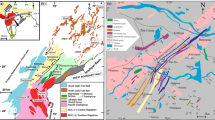Abstract
A number of microstructural features indicate a difference in the dominant deformation mechanism between the higher temperature Ryoke and the lower temperature Sambagawa and Shimanto metamorphic belts of Japan. The microstructures of metacherts containing deformed radiolaria are divided into two types: in both the Sambagawa and Shimanto belts the quartz grains are tabular while in the Ryoke belt they are equiaxed. TEM studies of these metacherts revealed that the tabular grains contain abundant subboundaries consisting of large numbers of network dislocations and bowe-out dislocations, while the equiaxed grains contain no subboundaries and have low densities of dislocations which are not bowed-out. There is a corresponding difference in the textures (lattice preferred orientation of quartz): the Ryoke metacherts display randomly distributed c-axes of quartz, while the Sambagawa and Shimanto metacherts show conspicuous crossed girdle patterns with some asymmetry. There is a third difference between these regions: in the metacherts of the Ryoke metamorphic belt, the strain magnitudes determined from deformed radiolaria increase with increasing volume fraction of mica in the same metamorphic P and T conditions, while in the Sambagawa and the Shimanto metamorphic cherts the strain magnitudes decrease with increasing the mica fraction.
These microstructures, textures, and rheological behaviours of quartz-mica rocks suggest a change of deformation mechanism between the lower temperature Sambagawa and Shimanto, and the higher temperature Ryoke metamorphic belts. Since random fabrics of c-axes of quartz are inconsistent with lattice rotation due to dislocation glide, the Ryoke metacherts may have deformed by pressure-solution.
Similar content being viewed by others
References
Ashy MF, Verall RA (1973) Diffusion accomodated flow and superplasticity. Acta Metall 21:149–163
Behrmann JH, Platt JP (1982) Sense of nappe emplacement from quartz c-axis fabrics; an example from Betic Cordilleras (Spain). Earth Planet Sci Lett 59:208–215
Borg IY, Handin JW (1966) Experimental deformation of crystalline rocks. Tectonophysics 3:249–368
Bouchez JL (1977) Plastic deformation of quartzites at low temperature in an area of natural strain gradient. Tectonophysics 39:25–50
Bouchez JL, Pecher A (1981) The Himalayan Main Central Thrust pile and its quartz-rich tectonites in central Nepal. Tectonophysics 78:23–50
Christie JM, Ord A (1980) Flow stress from microstructures of mylonites: example and current assessment. J Geophys Res 85:6253–6263
Faure M (1983) Eastward ductile shear during the early tectonic phase in the Sambagawa belt. J Geol Soc Jpn 89:319–329
Green II HW (1984) “Pressure solutions” creep: some causes and mechanisms. J Geophys Res 89:4313–4318
Griggs DT, Blasic JD (1965) Quartz: Anomalous weakness of synthetic crystals. Science 147:292–295
Kara I (1962) Studies on the structure of the Ryoke metamorphic rocks of the Kasagi district, southwest Japan. J Sci Hiroshima Univ Ser C 4:163–224
Hobbs BE, Means WD, Williams PF (1976) An outline of structural geology. John Wiley, New York, p 571
Jauol O, Tullis J, Kronenberg A (1984) The effect of varying water contents on the creep behavior of Heavitree quartzite. J Geophys Res 89:4298–4312
Kern H (1977) Preferred orientation of experimentally deformed limestone marble, quartzite and rock salt at different temperatures and state of stress. Tectonophysics 39:103–120
Kohlstedt DL, Weathers MS (1980) Deformation-induced microstructures, plaeopiezometers, and differential stresses in deeply eroded fault zones. J Geophys Res 85:6269–6285
Kronenberg AK, Tullis J (1984) Flow strengths of quartz aggregates: grain size and pressure effects due to hydrolytic weakening. J Geophys Res 89:4281–4297
Linker MF, Kirby SH, Ord A, Christie JM (1984) Effects of compression direction on the plasticity and rheology of hydrolytically weakened synthetic quartz crystals at atmospheric pressure. J Geophys Res 89:4241–4255
Lister GS, Paterson MS, Hobbs BE (1978) The simulation of fabric development in plastic deformation and its application to quartzite: The model. Tectonophysics 45:107–158
McCormick JW (1977) Transmission electron microscopy study of experimentally deformed synthetic quartz. Ph D Thesis. University of California, Los Angeles, p 171
Nicolas A, Poirier JP (1976) Crystalline plasticity and solid state flow in metamorphic rock. John Wiley & Sons, New York, p 444
Okamura Y (1960) Structural and petrological studies on the Ryoke gneiss and granodioritic complex of the Yanai district, Southwest Japan. J Sci Hiroshima Univ Ser C 3:143–213
Paterson MS (1973) Nonhydrostatic thermodynamics and its geologic applications. Rev Geophys Space Phys 11:355–389
Rutter EH (1976) The kinetics of rock deformation by pressure solution. Philos Trans R Soc London Ser A 283:203–219
Toriumi M (1982) Strain, stress and uplift. Tectonics 1:57–72
Toriumi M (1985) Two types of ductile deformation/regional metamorphic belt. Tectonophysics 113:307–326
Tullis J (1977) Preferred orientation of quartz produced by slip during plane strain. Tectonophysics 39:87–103
Tullis J, Christie JM, Griggs DT (1973) Microstructures and preferred orientations of experimentally deformed quartzites. Geol Soc Amer Bull. 84:297–314
Wilson CJL (1982) Texture and grain growth during the annealing. Textures and Microstructures 5:19–32
Author information
Authors and Affiliations
Rights and permissions
About this article
Cite this article
Toriumi, M., Teruya, J., Masui, M. et al. Microstructures and flow mechanisms in regional metamorphic rocks of Japan. Contr. Mineral. and Petrol. 94, 54–62 (1986). https://doi.org/10.1007/BF00371226
Received:
Accepted:
Issue Date:
DOI: https://doi.org/10.1007/BF00371226



